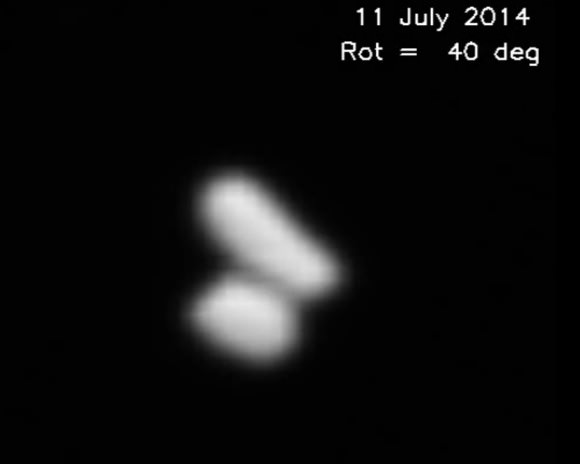A view of Comet 67P/Churyumov-Gerasimenko’s nucleus, appearing to show a double binary. Credit: ESA/Rosetta/MPS for OSIRIS Team MPS/UPD/LAM/IAA/SSO/INTA/UPM/DASP/IDA
It appears that Rosetta’s comet has a double nucleus. A video from the spacecraft speeding towards Comet 67P/Churyumov-Gerasimenko shows what looks two lobes touching each other, which could send a small wrinkle in the plans to land Philae on the comet’s surface later this year.
Edit, July 17: As the original video was removed off of YouTube, we have now replaced it with a GIF of the comet from here.
Citing a French space agency webpage that is now unavailable, the Planetary Society’s Emily Lakdawalla said she can hardly wait to see more views of the comet.
“The nucleus of the comet is clearly a contact binary — two smaller (and unequally sized object) in close contact,” she wrote, adding the nucleus measures 4 kilometers by 3.5 kilometers (2.5 miles by 2.17 miles).
It has a rotational period of about 12.4 hours.
“Philippe Lamy is quoted as estimating that the two components would have come into contact at a relative speed of about 3 meters per second in order to stick together in this way … This unusual shape could present a navigational challenge for the Philae lander team.
“The CNES release quotes Philae navigator Eric Jurado,” she continued, “as saying that ‘navigation around such a body should not be much more complex than around a nucleus of irregular spherical type, but landing the Philae probe [scheduled for November 11], however, could be more difficult, as this form restricts potential landing zones.’ ”

Only a handful of spacecraft have ever got up close to a comet (see the picture gallery of the others here). While a contact binary may be a surprise to scientists, the irregular shape spotted from afar was something that we’ve seen before in other comets.
“Irregular, elongated, and structured shapes are not uncommon for small bodies such as asteroids and comets,” stated the Max Planck Institute for Solar System Research in a release last week. “Of the five cometary nuclei that have been visited by spacecraft in close flybys so far, all are far from spherical.”
Makes us all eager to see what Rosetta finds out as it draws closer to the comet, for its rendezvous in August. The spacecraft will remain with the comet as 67P/Churyumov-Gerasimenko makes its closest approach to the Sun in 2015.
Some astronomers are already having fun imagining the possibilities of the new shape, such as the University of California, Berkeley’s Alex Parker.
.@elakdawalla Contact binary? Anvil? Boot? No, the morphology is clear: Churyumov-Gerasimenko is a rubber duckie. pic.twitter.com/AqtsXqQtVj
— Alex Parker (@Alex_Parker) July 15, 2014


Thanks for the leaked pics. I’m sure they will be up on the Rosetta Blog on Thursday. Can’t understand why ESA wants to sit on images for a week before releasing them. They make a great effort to involve the public in the mission, but don’t release the new images until Rosetta has cut the distance to 67P in half.
The video now shows that has been removed by the user